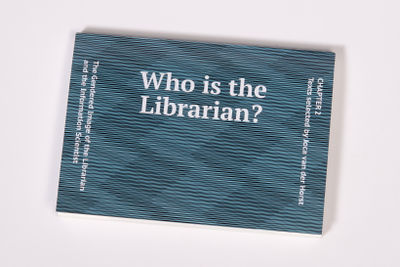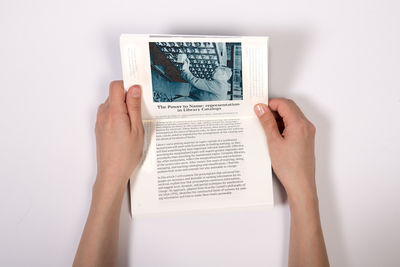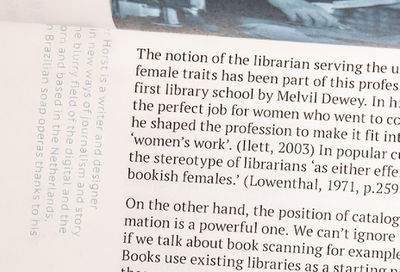User:Joca/Reader Joca: Difference between revisions
| (38 intermediate revisions by the same user not shown) | |||
| Line 1: | Line 1: | ||
= Who is the Librarian? = | = Who is the Librarian? = | ||
[[Image:reader_joca.jpg|thumbnail|right|400px]] | |||
=== The gendered image of the librarian and the information scientist === | === The gendered image of the librarian and the information scientist === | ||
Chapter 2 of ''Reflections on Book Scanning: A Feminist Reader'' | Chapter 2 of ''[[OuNuPo#The_Feminist_Reader|Reflections on Book Scanning: A Feminist Reader]]'' | ||
[https://www.zotero.org/groups/2084415/reader_2018/items/itemKey/7CXNXXZ9 PDF in Zotero (account and invitation to the Zotero group required)] | |||
=== Abstract === | === Abstract === | ||
The selection of articles in this chapter shows the construction of the feminized image of librarianship in the USA, and how this influenced the profession in other parts of the world. The texts analyze the stereotypes, and connect it to the bad status female dominated professions in general. The reader features articles annotations in the byline. These refer to other articles in the chapter, make connections to other chapters of the reader and add context. This is done in the form of e.g. short biographies of the authors, images and abstracts of the texts. | |||
=== Fragment of introduction === | |||
'Discussing the gender issues, (...) means to revaluate the work of the female librarian' concludes Maria Ferreira (2006) in her article concerning librarians in Brazil. So wo is the librarian? And who do we want this person (or system) to be in the future? It's up to us. | |||
[[User:Joca/Reader_Joca/introduction|Read the full introduction >>]] | |||
== Articles == | |||
=== Librarianship as a profession for college-bred women by Melvil Dewey === | |||
In this 1886 address to the alumni of the Columbia University Melvil Dewey describes his vision on librarianship: a highly educated person that helps the users of the library. Based on these qualities, he states that women who studied at college would be the ideal librarians. One year later Dewey would open the first Librarian School at Columbia University. | |||
=== The Power to Name: Representation in Library Catalogs by Hope A. Olson === | |||
In this article Hope Olson examines the causes of biases in cataloging system like the LCSH and DDC. Olson proposes several strategies to solve these problems, criticising the closed vocabulary and hierarchical structure present in the most popular systems. | |||
=== Gender and librarianship: revisiting trait theory by Rosemary C. Ilett === | |||
In this chapter Rosemary Illet uses feminist critique to show that the use trait theory to define an ideal type of profession ignores the relationship between professionalization, gender and power. She illustrates that by assessing librarianship through trait theory. | |||
=== O profissional da informacão e as questões de gênero by Maria M. Ferreira === | |||
Maria Mary Ferreira examines the conditions which make people choose to pursue a career in library sciences, focusing on ‘women’s work’ and the position of Brazilian women in the work space. | |||
=== As the library turns: Women, technology, and advertisements in the wired world by J. Dilevko === | |||
Dilevko analyzes advertisements in magazines for librarians and computer scientists. He finds out that in ads for technological products man appear more often than women, even if the commercial is aimed at librarians. | |||
=== The librarian and the information scientist: Different perceptions among Israeli information science students by N. Aharony === | |||
Aharony analyzes the differences in the professional image of the librarian and the information scientist in literature, and by interviewing students from different courses in information science in Israel. | |||
=== Information Science: Not Just for Boys Anymore by Jennifer Gilley === | |||
Jennifer Gilley compares the male/female ratio in different information science programs. She finds out that information science courses offered by library school have more female students than the average for the field. | |||
=== References === | |||
Aharony, N., 2006. Introduction, Literature Review, Conclusion. In The librarian and the information scientist: Different perceptions among Israeli information science students. ''Library & Information Science Research'' 28, 235–248. | |||
Dewey, M., 1886. ''Librarianship as a profession for college-bred women. An address delivered before the Association of collegiate alumnæ'', on March 13, 1886. Library bureau, Boston. | |||
Dilevko, J., 1998. Conclusion. Chapter 7 in ''As the library turns: Women, technology, and advertisements in the wired world'' (PhD), University of Western Ontario. 165 - 169. | |||
Ferreira, M.M., 2012. O profissional da informação no mundo do trabalho e as relações de gênero. ''Transinformação'' 15, 189 - 201. | |||
Gilley, J., 2006. Information Science: Not Just for Boys Anymore. ''American Libraries'' 37, 50–51. | |||
Ilett, R.C., 2003. Gender and librarianship: revisiting trait theory. Chapter 4 section 3 in ''Outstanding issues: gender, feminisms and librarianship'' (PhD). University of Glasgow, 97 - 116 | |||
Olson, H.A., 2001. The Power to Name: Representation in Library Catalogs. ''Signs'' 26, 639–668. | |||
== Design == | == Design == | ||
=== Book block === | === Book block === | ||
As I had never worked with the Espresso Book Machine before, I wanted to try it out within this project. The Espresso Book Machine is a combination of a printer and a book binding machine, which is able to print books on demand in print runs as low as one. To achieve its speed and to keep the printing affordable, a lot of aspects are standardized. For example, there is one kind of paper to print on, and the size of the book | [[Image:reader_joca_inside.jpg|thumbnail|right|400px]] | ||
[[Image:reader_joca_detail.jpg|thumbnail|right|400px]] | |||
As I had never worked with the Espresso Book Machine before, I wanted to try it out within this project. The Espresso Book Machine is a combination of a printer and a book binding machine, which is able to print books on demand in print runs as low as one. To achieve its speed and to keep the printing affordable, a lot of aspects are standardized. For example, there is one kind of paper to print on, and the size of the book has to be between 114mmx127mm and 200mmx266mm. | |||
In the design of this reader, I was interested in finding a non-conventional format that could be printed using the Espresso Book Machine. I got inspired by the [http://grafischbedrijf.royaljongbloed.com/dwarsligger-book/ Dwarsligger]. By changing the orientation of the pages, and the use of a special binding, the Dwarsligger makes it possible to create more compact and durable books. | In the design of this reader, I was interested in finding a non-conventional format that could be printed using the Espresso Book Machine. I got inspired by the [http://grafischbedrijf.royaljongbloed.com/dwarsligger-book/ Dwarsligger]. By changing the orientation of the pages, and the use of a special binding, the Dwarsligger makes it possible to create more compact and durable books. | ||
Within this project, I found the change in orientation interesting for | Within this project, I found the change in orientation interesting for different reasons: The 'horizontal' pages of the Dwarsligger makes turning the pages of the book reminiscent of reading and scrolling down a text on a screen. Next to that, OCR software like Tesseract is able to process text in just one orientation at a time. | ||
By having the texts and the annotations in different orientations, readers can change their focus from one to the other. And the orientation they choose to scan the book in, influences which text is recognized by the OCR software. In my tests this worked out quite well, and the results improved when I gave a different color to the annotations. | |||
One of the aspects the connect the different chapters of the reader is the choice of a typeface designed by a woman. I chose [https://en.wikipedia.org/wiki/PT_Fonts PT Serif & PT Sans Caption] (by Alexandra Korolkova, in collaboration with Olga Umpeleva and Vladimir Yefimov. | |||
=== Cover === | |||
The cover is based on my [[User:Joca/raw-audio-bitmap|experiments on turning RAW audio into bitmap images]]. As an input I chose pure tones that I generated in Audacity. This particular image is the result of a [[File:Cover sound raw.ogg|blockwave of 4hz fading out, while a saw tooth wave of 4hz is fading in]]. The result of my pipeline using Audacity and Imagemagick gives images in black and white. I used GIMP to add the blue as the background color. | |||
=== Format & Production === | |||
Width: 176mm, Height: 125mm (B5, horizontal). | |||
Horizontal spine, 202 pages, glue binding, softcover | |||
This reader is printed and bound at Betty, the [https://www.abc.nl/selfpublishing Espresso Book Machine] of the American Book Center in Amsterdam. | This reader is printed and bound at Betty, the [https://www.abc.nl/selfpublishing Espresso Book Machine] of the American Book Center in Amsterdam. | ||
Latest revision as of 19:33, 27 March 2018
Who is the Librarian?
The gendered image of the librarian and the information scientist
Chapter 2 of Reflections on Book Scanning: A Feminist Reader
PDF in Zotero (account and invitation to the Zotero group required)
Abstract
The selection of articles in this chapter shows the construction of the feminized image of librarianship in the USA, and how this influenced the profession in other parts of the world. The texts analyze the stereotypes, and connect it to the bad status female dominated professions in general. The reader features articles annotations in the byline. These refer to other articles in the chapter, make connections to other chapters of the reader and add context. This is done in the form of e.g. short biographies of the authors, images and abstracts of the texts.
Fragment of introduction
'Discussing the gender issues, (...) means to revaluate the work of the female librarian' concludes Maria Ferreira (2006) in her article concerning librarians in Brazil. So wo is the librarian? And who do we want this person (or system) to be in the future? It's up to us.
Articles
Librarianship as a profession for college-bred women by Melvil Dewey
In this 1886 address to the alumni of the Columbia University Melvil Dewey describes his vision on librarianship: a highly educated person that helps the users of the library. Based on these qualities, he states that women who studied at college would be the ideal librarians. One year later Dewey would open the first Librarian School at Columbia University.
The Power to Name: Representation in Library Catalogs by Hope A. Olson
In this article Hope Olson examines the causes of biases in cataloging system like the LCSH and DDC. Olson proposes several strategies to solve these problems, criticising the closed vocabulary and hierarchical structure present in the most popular systems.
Gender and librarianship: revisiting trait theory by Rosemary C. Ilett
In this chapter Rosemary Illet uses feminist critique to show that the use trait theory to define an ideal type of profession ignores the relationship between professionalization, gender and power. She illustrates that by assessing librarianship through trait theory.
O profissional da informacão e as questões de gênero by Maria M. Ferreira
Maria Mary Ferreira examines the conditions which make people choose to pursue a career in library sciences, focusing on ‘women’s work’ and the position of Brazilian women in the work space.
As the library turns: Women, technology, and advertisements in the wired world by J. Dilevko
Dilevko analyzes advertisements in magazines for librarians and computer scientists. He finds out that in ads for technological products man appear more often than women, even if the commercial is aimed at librarians.
The librarian and the information scientist: Different perceptions among Israeli information science students by N. Aharony
Aharony analyzes the differences in the professional image of the librarian and the information scientist in literature, and by interviewing students from different courses in information science in Israel.
Information Science: Not Just for Boys Anymore by Jennifer Gilley
Jennifer Gilley compares the male/female ratio in different information science programs. She finds out that information science courses offered by library school have more female students than the average for the field.
References
Aharony, N., 2006. Introduction, Literature Review, Conclusion. In The librarian and the information scientist: Different perceptions among Israeli information science students. Library & Information Science Research 28, 235–248.
Dewey, M., 1886. Librarianship as a profession for college-bred women. An address delivered before the Association of collegiate alumnæ, on March 13, 1886. Library bureau, Boston.
Dilevko, J., 1998. Conclusion. Chapter 7 in As the library turns: Women, technology, and advertisements in the wired world (PhD), University of Western Ontario. 165 - 169.
Ferreira, M.M., 2012. O profissional da informação no mundo do trabalho e as relações de gênero. Transinformação 15, 189 - 201.
Gilley, J., 2006. Information Science: Not Just for Boys Anymore. American Libraries 37, 50–51.
Ilett, R.C., 2003. Gender and librarianship: revisiting trait theory. Chapter 4 section 3 in Outstanding issues: gender, feminisms and librarianship (PhD). University of Glasgow, 97 - 116
Olson, H.A., 2001. The Power to Name: Representation in Library Catalogs. Signs 26, 639–668.
Design
Book block
As I had never worked with the Espresso Book Machine before, I wanted to try it out within this project. The Espresso Book Machine is a combination of a printer and a book binding machine, which is able to print books on demand in print runs as low as one. To achieve its speed and to keep the printing affordable, a lot of aspects are standardized. For example, there is one kind of paper to print on, and the size of the book has to be between 114mmx127mm and 200mmx266mm.
In the design of this reader, I was interested in finding a non-conventional format that could be printed using the Espresso Book Machine. I got inspired by the Dwarsligger. By changing the orientation of the pages, and the use of a special binding, the Dwarsligger makes it possible to create more compact and durable books.
Within this project, I found the change in orientation interesting for different reasons: The 'horizontal' pages of the Dwarsligger makes turning the pages of the book reminiscent of reading and scrolling down a text on a screen. Next to that, OCR software like Tesseract is able to process text in just one orientation at a time.
By having the texts and the annotations in different orientations, readers can change their focus from one to the other. And the orientation they choose to scan the book in, influences which text is recognized by the OCR software. In my tests this worked out quite well, and the results improved when I gave a different color to the annotations.
One of the aspects the connect the different chapters of the reader is the choice of a typeface designed by a woman. I chose PT Serif & PT Sans Caption (by Alexandra Korolkova, in collaboration with Olga Umpeleva and Vladimir Yefimov.
Cover
The cover is based on my experiments on turning RAW audio into bitmap images. As an input I chose pure tones that I generated in Audacity. This particular image is the result of a File:Cover sound raw.ogg. The result of my pipeline using Audacity and Imagemagick gives images in black and white. I used GIMP to add the blue as the background color.
Format & Production
Width: 176mm, Height: 125mm (B5, horizontal).
Horizontal spine, 202 pages, glue binding, softcover
This reader is printed and bound at Betty, the Espresso Book Machine of the American Book Center in Amsterdam.



